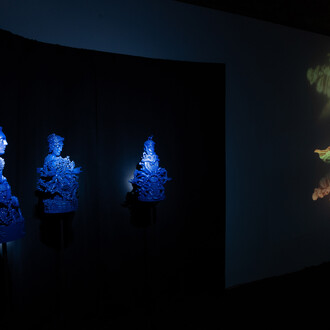Hunt Kastner is pleased to present a group exhibition featuring early work by five influential artists who studied at the Prague Academy of Fine Arts in the 1990s, examining a vital period in their early careers as they each developed their own unique visual languages. It was a time marked by the fresh hope following the fall of totalitarianism and the excitement surrounding the promise of a new century. The exhibition is divided into two sections. The first section showcases a series of paintings, created while most of the artists were still students. The second section features selected works, more representative of their current practices, which evolved around their time of graduation. The documentary video Vide (2003), a collaboration between Ján Mančuška and Zbyněk Baladrán, crucially connects the two sections of the exhibition, examining themes of continuity and discontinuity within the context of Czech art.
The emotions that the title of this exhibition seeks to evoke among the "local" - a fictional collective characterized by place - seem almost moralistic on a personal level. Does it also apply to me - because I come from here? Is it the stigma of locality? Or perhaps even provinciality? And can I get rid of it if I go out into the world? Wasn't escape from the stigma one of the great motives of Czech art in the post-socialist era? And doesn't it remain one, only in other forms? Might it have been chosen as the exhibition title precisely for its immediate impact connected with the transformations of the meaning of "local", in addition to being a direct reference to Jiří Skála's graduation work from 2004 of the same name.
Skála's video installation, Local stigma, which was first publicly exhibited in Futura Gallery in Prague, consisted of four projections each directed on a white canvas installed on the four walls of the exhibition space. On each white canvas, was a film documenting a different artist as they put together and primed a canvas for a painting (of the same dimensions). Before our eyes, the transformation of the natural (beige) canvas into a neutral white surface is taking place, ready for any further creation: painting, writing, imprinting, collaging, projecting. Every artist knows this situation. A writer in front of a white sheet of paper inserted into a typewriter or placed on a desk. We can go all the way back to the very beginning of the universe, when "something" had to somehow emerge from "nothing". From a certain point in history, in the period between Russian Constructivism and the end of the 1950s, the technical basis of painting was transformed into an independent work: white monochromes (K. Malevich, R. Rauschenberg, P. Manzoni, R. Ryman) or, more generally, monochrome paintings (Rodchenko, Y. Klein, E. Kelly). Jiří Skála recalls in the defence of his thesis that the immediate impetus for the idea of filming four colleagues preparing a white canvas was the performance by Elmgreen & Dragset, Powerless structures, fig. 44, in which they painted (and again cleaned) a glass cube white from the inside during the opening.
Skála's video installation plays with many references. On the one hand, it evokes archetypal stories of journeys into origins, on the other hand, it materializes in real time the very procedural aspects of "doing" (R. Morris). But where, and in what, to look for that local stigma? According to a contemporary explanation, the point of the work was to transform painting - then a prevalent but at the same time commodified medium - into a conceptual or post-conceptual problem. Into a video installation, for example. If you turn painting into a post-conceptual problem, you are relieved of the burden, the stigma weighing down the local environment, and you enter a multimedia landscape. There, art in the early stages of the turn was not only discovering the history and theory of media, but also becoming aware of the political dimensions of the medium as part of the culture industry. This led to a search for escape routes, or an attempt to co-opt practices and media representations of reality that were in opposition to mainstream media images (documentary and subversive montage, anti-advertising, spray painting, but also practices and images of the banal everyday).
The reconstruction of this reflection from 2004 not only offers us the possibility of comparison with the current era, but above all - and this is the aim of this exhibition - it offers us a point from which to look at the work of all the other artists of the same generation exhibited. It is a probe into the post-conceptual turn in local art that Skála's work thematized.
(Text by Vít Havránek)
(Featuring artists: Zbyněk Baladrán, Ján Mančuška, Jiří Skála, Tomáš Svoboda and Tomáš Vaněk)












